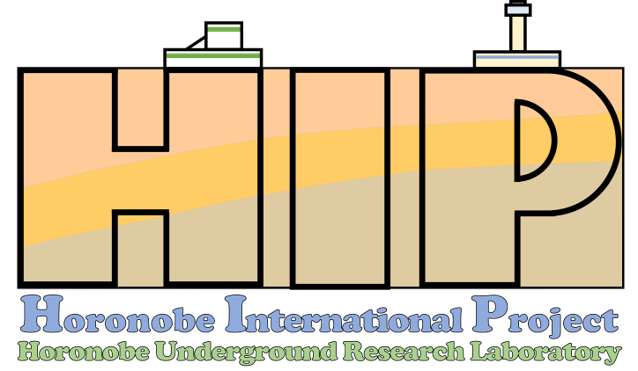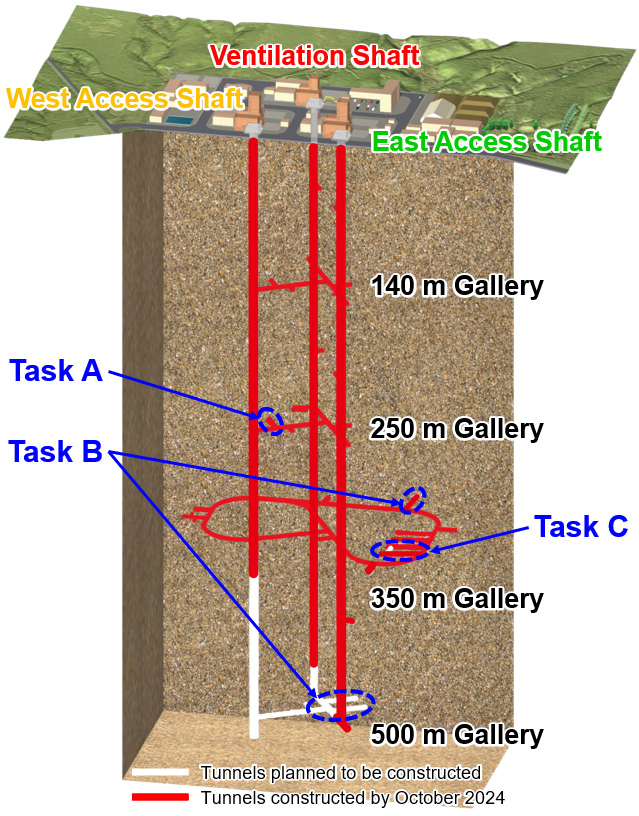Overview
The Horonobe International Project (HIP)
The Horonobe International Project (HIP) is an international project, as part of the Horonobe Underground Research Laboratory (URL) Project, with the main theme of 'Challenges for Developing Advanced Technologies and Human Resources Towards Long-Term Implementation of Geological Disposal'. The HIP was set up as an NEA* joint project in February 2023 and successfully undertaken in Phase 1 (February 2023 to March 2025). This has now been taken forward into Phase 2 (April 2025 to March 2029) with the participation of 10 organisations from Australia, Bulgaria, Germany, Korea, Romania and United Kingdom as well as Japan.

The main objectives of the HIP are to:
- Develop and demonstrate advanced technologies to be used in repository design, operation and closure, and a realistic safety assessment in deep geological disposal; and
- Encourage and train the next generation of engineers and researchers by sharing and transferring a vast amount of knowledge and experience developed to date in relevant organisations worldwide.
In the HIP, our priority should be given to promoting multilateral collaboration on the following three tasks as these are of great interest to many organisations worldwide as recognised during the International Roundtable discussions on the final disposal of high-level radioactive waste and spent nuclear fuel in 2019 and 2020**:
- Task A : Solute transport experiment with model testing;
- Task B : Systematic integration of repository technology options; and
- Task C : Full-scale EBS dismantling experiment.
*NEA: OECD Nuclear Energy Agency (https://www.oecd-nea.org/)
**A summary report is available on the NEA website:
https://www.oecd-nea.org/jcms/pl_39718/international-roundtable-on-the-final-disposal-of-high-level-radioactive-waste-and-spent-fuel-summary-report

Background
In the International Roundtable discussions, it was very much agreed that enhancing international cooperation would be of great importance to maintain and strengthen technological capabilities for the final disposal. Looking towards the long-term effective implementation of a geological disposal project from an international perspective, the technical understanding for the project should be further strengthened by, for example, transforming research and development (R&D) results into practical and reliable technologies and managing temporal uncertainties associated with long-term predictive modelling. To this end, international cooperation utilising URLs made internationally available should be facilitated as sharing financial and human resources as well as transferring R&D knowledge and experience to the next generation of engineers and researchers would be of much value and benefit.
News
- 4 November 2025
- ‘NEA Horonobe International Project (HIP): Interim Report for Phase 1 (February 2023 - March 2025)’ was published. The report is available to view in PDF format on the NEA website: https://www.oecd-nea.org/jcms/pl_111824/nea-horonobe-international-project-hip-interim-report-for-phase-1-february-2023-march-2025
- 24 July 2025
- The Australian Radioactive Waste Agency (ARWA) officially confirmed their participation in Tasks A, B and C.
- 13 June 2025
- The Australian Radioactive Waste Agency (ARWA) became a new participating organisation in the HIP following the unanimous approval of the Management Board.
- 5 June 2025
- The sixth Management Board meeting was held online.
- 18 March 2025
- A decision was made to take the HIP forward into Phase 2 (April 2025 to March 2029) with the written approval of the following participating organisations:
- BGE: The Bundesgesellschaft für Endlagerung mbH, Germany;
BGS: The British Geological Survey, UK;
CRIEPI: The Central Research Institute of Electric Power Industry, Japan;
KAERI: The Korea Atomic Energy Research Institute, Korea;
NUMO: The Nuclear Waste Management Organization of Japan, Japan;
RATEN: The Regia Autonomă Tehnologii pentru Energia Nucleară, Romania;
RWMC: The Radioactive Waste Management Funding and Research Center, Japan;
SERAW: The State Enterprise Radioactive Waste, Bulgaria; and
JAEA.
